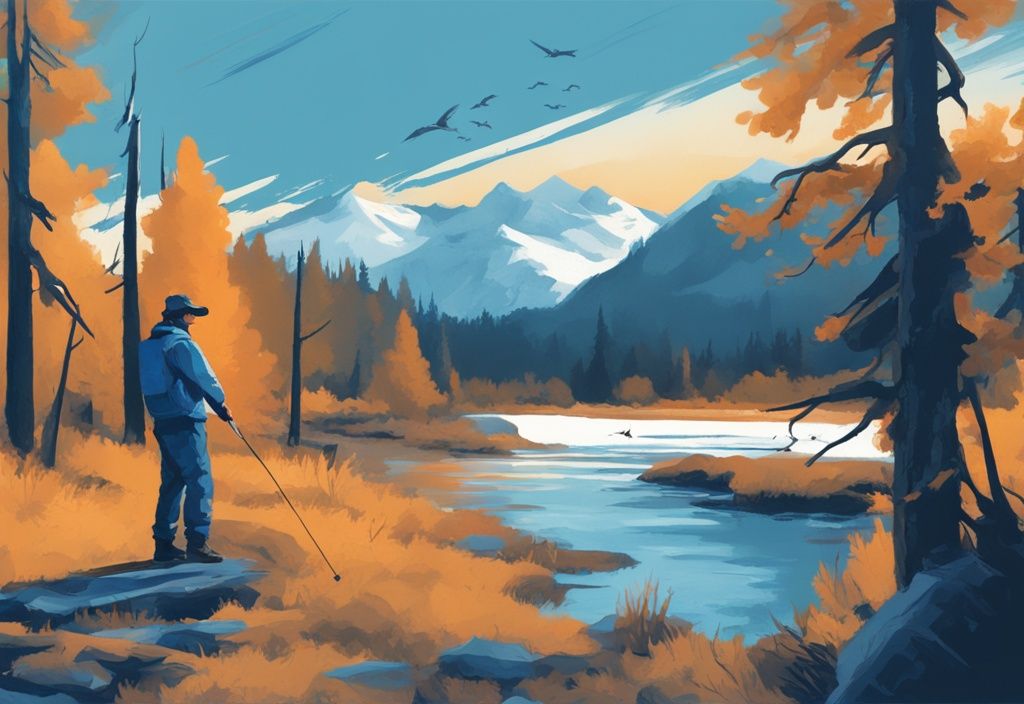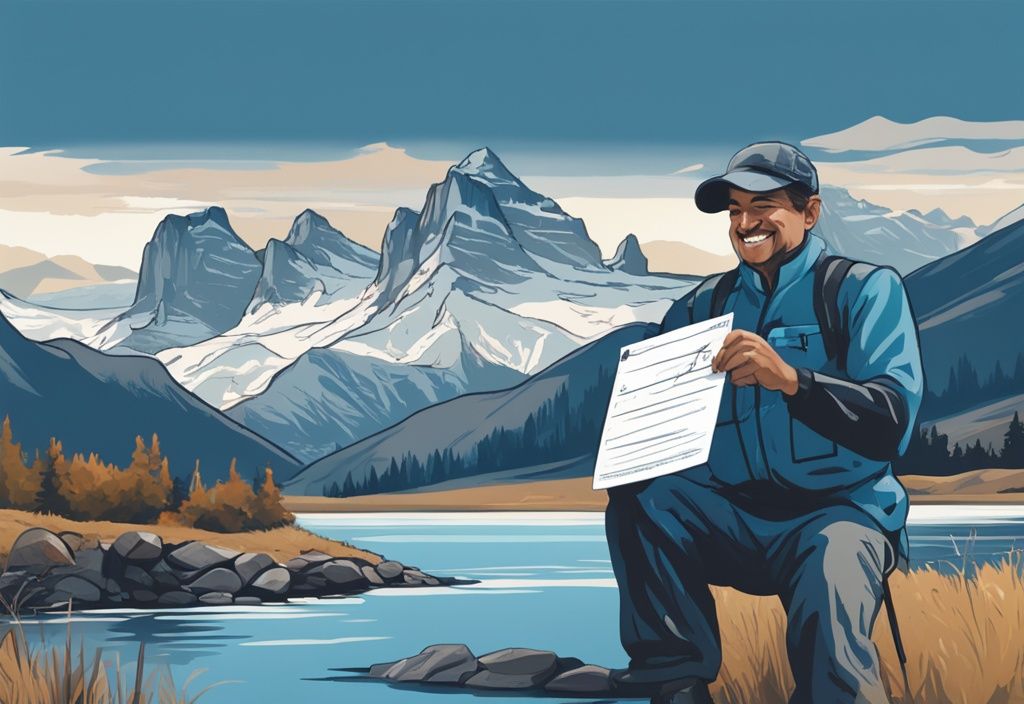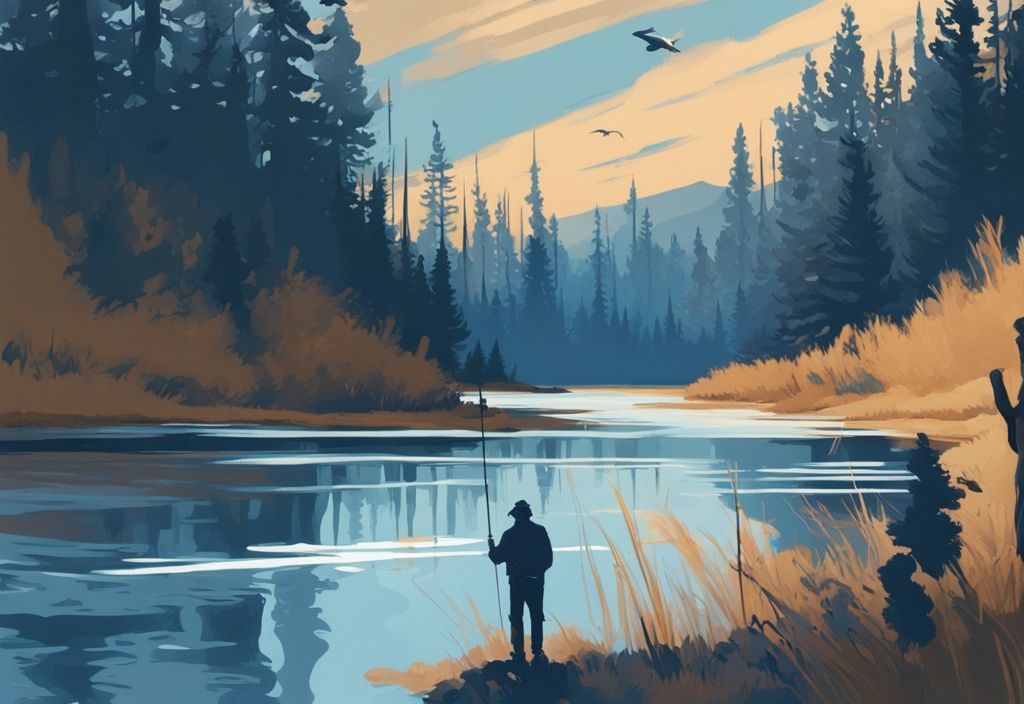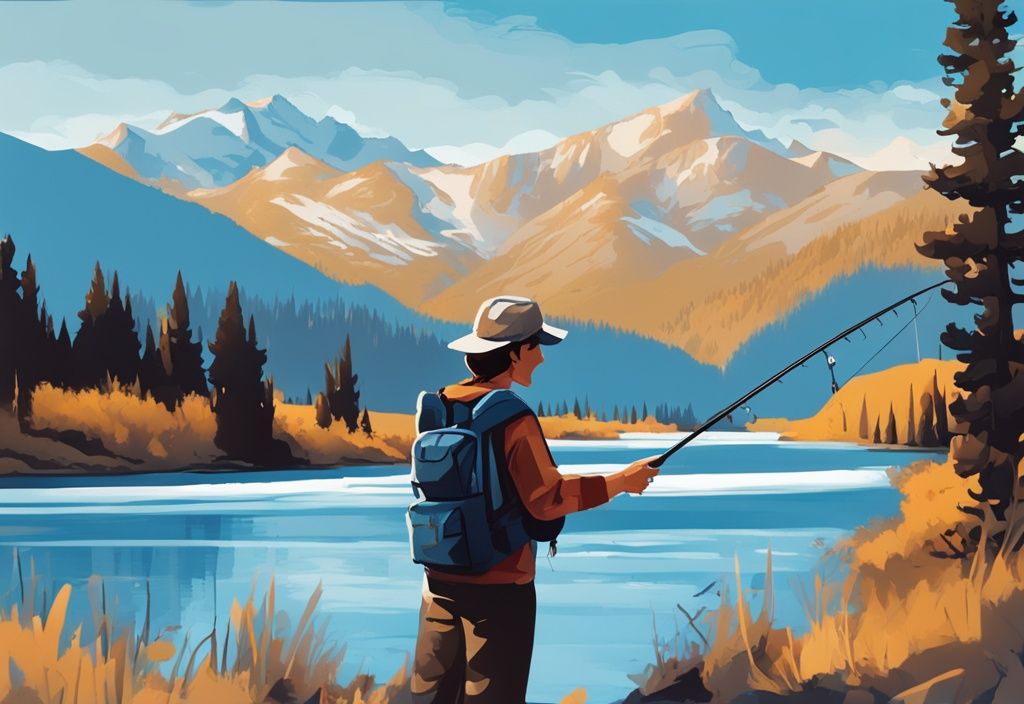Ever hooked a whopper and realized you left your fishing license at home, folks? It’s easier than untangling a line snarl to obtain a fishing license in Montana, whether you’re a local or just passing through. Packed with untouched wildlife and tranquil waters, this fishing haven is worth every bit of the paperwork.
In this practical guide, we’ll reel in everything you need to know. Legal requirements and types of licenses, right through to costs and some neat tricks of the trade—let’s tackle this together to ensure every one of your fishing experiences is as worry-free as a day on a quiet Montana lake.
Remember, it’s all in support of Montana’s rich aquatic habitats. Let’s cast a line and dive in, shall we?
How to Obtain a Fishing License in Montana
Obtaining a fishing license in Montana is a pretty straightforward process, no matter if you’re a resident or a nonresident. Follow these steps to make sure you’re in line with Montana’s fishing regulations and supporting the state’s conservation efforts.
Steps to Qualify for a Resident Fishing License in Montana
To qualify for a resident fishing license in Montana, you must meet specific residency criteria. You’ll need to primarily reside in Montana for at least 180 consecutive days. Additionally, filing Montana state taxes and, if applicable, registering your vehicle in Montana, is required.
Residency Requirements
According to the Montana Code Annotated (MCA) 87-2-102 and 202, you have to demonstrate your residency by providing the following:
- Proof of primary residency in Montana for at least 180 consecutive days.
- Filing Montana state income taxes.
- Registering your vehicle in Montana if applicable.
Documentation Required
When applying for a resident fishing license, you need to present:
- A Montana driver’s license or state ID card.
- Utility bills or lease agreements showing your residence.
- Additional documentation for special licenses if you are military personnel, a disabled individual, or a senior.
Where and How to Purchase Your Montana Fishing License
In Montana, you have several convenient options for purchasing a fishing license, each catering to different preferences.
Purchasing Online
You can easily buy your fishing license online through the Montana Fish, Wildlife & Parks website. Create an online account, provide necessary personal details, and enter payment information.
Convenient In-Person Locations
If you prefer buying your license in person, visit local outlets like fly shops, licensed agents (including retailers, convenience stores, and sporting goods stores), or any Montana Fish, Wildlife & Parks office. Remember to bring all required documentation with you when purchasing in person.
Understanding Fishing Regulations in Montana
After obtaining a fishing license in Montana, it’s crucial to familiarize yourself with the fishing regulations specific to each district. The state is divided into the Western, Central, and Eastern fishing districts, and each comes with its own season openings and specific guidelines.
Regulations by Fishing Districts
- Western District: Rivers and streams are open from the third Saturday in May through November 30, with lakes and reservoirs open year-round.
- Central and Eastern Districts: Rivers, streams, lakes, and reservoirs are open year-round.
Catch Limits and Special Restrictions
Adhere to size, species, and bag limit restrictions. Some areas may have additional regulations or require special permits, such as the Combined Angling Tag. Review the detailed regulations in the Montana fishing guide, available online and at license vendors.
By following these guidelines and understanding the key factors, you can obtain a fishing license in Montana and enjoy a lawful, engaging fishing experience, all while supporting vital conservation efforts in the state.
Why You Need a Fishing License in Montana
When you want to fish in Montana, you’ve got to abide by the state’s rules. Let’s dive into why securing that license is a must and how it helps you contribute to more than just your fishing tackle box.

Legal Requirement
Obtaining a fishing license in Montana isn’t just a suggestion—it’s a legal must for anyone 12 years old or above looking to wet a line in these waters. Imagine this: you’re out on the lake, the sun setting behind the mountains, when a game warden asks to see your fishing license. Without it, you’re facing hefty fines and penalties, which, let’s be honest, can really put a damper on a great day of fishing.
Fishing regulations here are strict to ensure everyone follows the rules and keeps our fisheries in top shape. When you buy that license, it’s issued just to you—nontransferable and nonrefundable. So, make sure you’re squared away before you cast that first line.
Conservation and Funding
Ever wonder where your money goes when you obtain a fishing license in Montana? Those dollars are vital for conservation efforts that keep our fish populations healthy and habitats thriving. Picture the pristine streams and lakes full of fish—that’s what your license fees support. It’s a small price to pay to ensure that future generations can enjoy the same joy of fishing in these beautiful waters.
Part of this effort includes the Angler Aquatic Invasive Species Prevention Pass (AISPP). This pass is crucial for combating invasive species that threaten our waterways. Thanks to initiatives funded by the AISPP, our rivers and lakes remain diverse and vibrant, protecting the aquatic life we love to fish for.
Remember, every license purchase contributes to safeguarding Montana’s natural treasures. So next time you’re out there casting your line, you’ll know you’re part of something much bigger—preserving nature’s bounty for all to enjoy.
Types and Costs of Montana Fishing Licenses
Licenses for Residents
Available Types and Concerned Fees
To obtain a fishing license in Montana as a resident, there are tailored options for different age groups and needs. First off, the essential Conservation License, which is $8 for adults. If you’re between 12-17 or over 62, you’re in luck with a discounted rate of $4.
Next up, every angler needs the Aquatic Invasive Species Prevention Pass (AISPP) at just $2. Now, if you’re gearing up for an entire season, the Full Season Fishing License comes in at $21. But for youths and seniors, it’s just $10.50. It’s a great way to ensure the whole family gets in on year-round fishing adventures.
For those who fish sporadically, a Short-Term License is available. It covers 2 consecutive calendar days and is priced universally at $5, regardless of age.
Licenses for Nonresidents
Available Types and Concerned Fees
If you’re a nonresident looking to obtain a fishing license in Montana, several ticket options cater to your needs. The basic Conservation License is $10, with the required AISPP adding another $7.50 to support these vital conservation efforts.
Nonresident anglers have a range of licenses to choose from. For short visits, a 1-Day Fishing License costs $31.50, and you can add another day for $14 each. For a bit longer stay, the 5-Day Fishing License is $73.50, providing a cost-effective option, again with a $14 charge for each additional day.
Planning a deeper dive into Montana’s waters? The Season License at $117.50 offers unrestricted access all season long. Plus, nonresident youths aged 12-15 have their own structured fees: $24 for a 1-Day License, $66 for a 5-Day License, and $110 for the whole season. It’s a great way to make fishing accessible for young enthusiasts.
Steps to Qualify for a Resident Fishing License in Montana
To get a resident fishing license in Montana, you need to check a few important boxes. Here’s a handy rundown of what you need, from residency requirements to ensuring you’ve got the right paperwork ready.
Residency Requirements
So, you want to obtain a fishing license in Montana as a resident? First things first, you’re going to need to prove you’re a true Montanan. According to MCA 87-2-102 and 202, you’ve got to live in Montana for at least 180 consecutive days. This isn’t about just crashing here for a season and hoping to snag a resident license; it’s about showing you’re committed to the Last Best Place.
You’ll also need to file Montana state taxes, which is a pretty clear signal that you’re pitching your tent here for the long haul. And don’t forget to register your vehicle in Montana—another crucial step that ties you firmly to our big sky state. When you’ve got all these ducks in a row, you’ll be in good shape to obtain a fishing license in Montana. These steps make sure you’re regarded as a bona fide resident, opening those waters up to you.
Documentation Required
Alright, let’s talk paperwork. To obtain a fishing license in Montana as a resident, you’ll need to pull together some documentation. A Montana driver’s license or ID card should be your first port of call—this is your primary proof of residency.
But don’t stop there. Utility bills, lease agreements, these are the unsung heroes of your application. They back up your claim of a permanent address in Montana. Also, keep in mind that special licenses exist for military personnel, disabled individuals, and seniors, which might require extra documents. Having everything ready means you can hit the water with minimal fuss, and more time for what really matters—fishing.
Where and How to Purchase Your Montana Fishing License
When it comes to obtaining a fishing license in Montana, the process is straightforward whether you prefer the convenience of online purchasing or enjoy the traditional route of visiting a local store. Let’s dive into both methods to get you started.

Purchasing Online
To obtain a fishing license in Montana online, head over to the Montana Fish, Wildlife & Parks website. The adventure begins by setting up an online account. You’ll need some basic personal information, so have your payment details handy. The website is designed to be user-friendly, leading you smoothly through each form and step. In no time, you’ll have your license without ever leaving the comfort of your couch. It’s as simple as casting a line into a well-stocked pond!
Convenient In-Person Locations
If you’re like me and appreciate a good chat about the latest fishing spots, obtaining a fishing license in Montana in person might be your style. There are plenty of places to get it done, from local fly shops to big retailers, convenience stores, and the sporting goods stores where you probably spend a good chunk of your time anyway. Don’t forget that Montana Fish, Wildlife & Parks offices are also great spots to get your license. Just make sure you bring the necessary documents, like proof of residency or any special status like military or senior discounts. This way, you can get immediate help and answers to any questions that might pop up. It’s like having a fishing guide right next to you, ready to reel in the good advice.
Understanding Fishing Regulations in Montana
Montana is a fishing paradise, brimming with diverse waters and plentiful fish species. Before diving into these pristine waters, it’s important to understand the fishing regulations, which you can find detailed on the Montana Fish, Wildlife & Parks website, to ensure a fun and legal experience.
Regulations by Fishing Districts
Montana is divided into distinct fishing districts, each with its specific regulations. Knowing these regulations is crucial before you even think about obtaining a fishing license in Montana.
In the Western District, rivers and streams open up from the third Saturday in May through November 30. Imagine casting your line in the early morning mist of a mountain stream, with the songs of birds as your background music. But don’t worry, lakes and reservoirs in this district are accessible all year round, perfect for both the casual weekend trip and the dedicated angler seeking that trophy catch.
The Central District offers even more flexibility. Here, rivers, streams, lakes, and reservoirs are open all year. Picture yourself ice fishing in winter or fly-fishing on a warm summer day, the options are limitless. This district caters to a variety of fishing preferences and conditions throughout the different seasons.
Similarly, the Eastern District boasts year-round access to its fishing spots. Whether you’re fishing under the vast Montana sky in the summer or braving a chilly winter morning, this district ensures you can fish whenever the mood strikes. Knowing these open seasons is key to planning your fishing trips effectively.
Catch Limits and Special Restrictions
Once you obtain a fishing license in Montana, you must adhere to the catch limits and special restrictions. These rules are not just bureaucratic red tape, but essential measures to protect fish populations and ensure sustainable practices for future generations of anglers.
Licensed fishers have to follow specific size, species, and bag limit restrictions. These vary depending on the type of fish and the location. Imagine the thrill of catching a massive trout, only to remember it’s too big to keep—familiarizing yourself with these regulations is vital before you start fishing.
Some areas in Montana have additional regulations or require special permits, like the Combined Angling Tag. These permits are necessary for fishing in certain protected or highly regulated waters and play a part in the broader conservation strategy to maintain healthy aquatic ecosystems.
For detailed information on regulations, including any updates or changes, the Montana fishing guide is an invaluable resource. Available both online and at various license vendors, it ensures you have access to the latest rules no matter where you obtain your fishing license in Montana. Always carrying a copy of this guide or having it readily accessible can significantly enhance your fishing experience, helping you stay compliant with all legal requirements.
So, grab your gear, familiarize yourself with the regulations, and enjoy the incredible fishing opportunities Montana has to offer.
Procedure to Replace a Lost or Stolen Montana Fishing License
Alright, we’ve all been there—you reach into your pocket and suddenly realize your Montana fishing license is missing. Don’t sweat it, folks! Let’s dive into the easy steps to obtain a fishing license in Montana again.
Steps for Getting Your License Reissued
- Visit the Montana Fish, Wildlife & Parks Website: Fire up your browser and head to the official website. Navigate to the fishing license section. This spot is your go-to for all the latest updates and instructions.
- Review Reissue Requirements: You’ll likely need to pay a reissue fee. Make sure your personal details and payment info are on hand. Prepping these ahead of time will make the whole process sail smoothly.
- Contact Customer Service: Hit a snag? No worries! The folks at Montana Fish, Wildlife & Parks are there to help. If you run into any issues, their customer support team can guide you through the rough patches.
By following these steps, you can quickly replace your lost or stolen fishing license, ensuring you remain compliant with Montana’s fishing regulations. After all, the fish won’t wait—so get back out there and keep those lines wet!
Practical Tips for Using Your Fishing License in Montana
Planning A Fishing Trip with Your License
Before you hang that ‘Gone Fishing’ sign on your door, make sure your fishing license is up to date. It’s a small detail, but oh so important. In Montana, different licenses cover various needs. You don’t want to be all set for a trout expedition only to find out your license doesn’t match your plans!

Don’t just stop at your license; consider camping out in some of the splendid Montana State Parks. These spots aren’t just picturesque—they’re fishing goldmines. Imagine waking up with the sunrise, the cool Montana breeze, and the whispers of a perfect fishing day ahead.
Staying Updated with Regulation Changes
Regulations change, and trust me, you don’t want to be the angler caught out of the loop. The Montana Fish, Wildlife & Parks website should be one of your frequent haunts. You’ll find updates that can save you a lot of hassle—and fines. Conservation is key, and staying informed ensures you’re doing your part. Plus, nothing feels worse than planning a day out only to learn you’ve crossed a new boundary.
Restrictions and Limitations for Different Types of Fish
Montana’s diverse waters house many fish, each playing by different rules. Knowing the specifics can make the difference between a fantastic day on the water and a regrettable mistake. There’s something special about pulling in a hefty catch, but always remember to check the size limits, catch quotas, and seasonal closures. These rules aren’t just red tape; they help sustain our beloved fish population. Fishing within these guidelines makes your adventure in Montana worry-free and keeps our waters thriving for the next generation.
Frequently Asked Questions
Do I need a fishing license if I am under 12 years old?
No, kids 11 years old or younger don’t need a fishing license in Montana. But hey, they still have to follow all fishing regulations and catch limits. Think of it as part of the adventure, ensuring we all play fair and keep our waters thriving.
What documentation is required to confirm residency for a fishing license?
To confirm residency for a Montana fishing license, you’ll need a Montana driver’s license or ID card. Other documents like utility bills or lease agreements can also do the trick. It’s a small hassle, but it helps keep everything above board.
How can I purchase a fishing license online in Montana?
If you’re looking to obtain a fishing license in Montana online, head over to the Montana Fish, Wildlife & Parks website. Create an account, fill in your personal details, and you’re just a few clicks away from hitting the water. Easy peasy, and you can do it all from your couch.
What are the available discounts for seniors, veterans, or disabled?
Montana has got some sweet deals for seniors, veterans, and those with disabilities. To snag these discounted fishing licenses, make sure you have the right documentation to confirm your status. It’s Montana’s way of saying thank you.
What are the penalties for fishing without a license in Montana?
Fishing without a license in Montana can land you in hot water, with fines and possible legal consequences. Keeping up with the regulations isn’t just about avoiding trouble; it’s about ensuring that fish populations and our beloved aquatic habitats stay healthy for generations of anglers to come.
Conclusion
Obtaining a fishing license in Montana is a key part of ensuring not just the legality of your fishing endeavors, but also the ongoing health of the state’s aquatic ecosystems. By securing a license, you’re not just ticking off a legal requirement—you’re actively contributing to conservation efforts that keep Montana’s fish populations robust and their habitats pristine.
Ever wonder where those fishing license fees go? For more information on regulations, you might find the Skyway fishing pier rules insightful. Think fish restoration projects, battles against invasive species, and protection of endangered natives. These aren’t abstract efforts; they’re concrete actions that make a real difference, all funded by your license fees. It’s pretty amazing when you think about it—each license helps keep Montana’s waters teeming with life.
Don’t overlook the importance of staying up-to-date with current regulations and securing the correct license type. Trust me, nothing puts a damper on a fishing trip faster than running afoul of the law. Whether you’re a proud Montanan or visiting from out of state, understanding the steps to obtain a fishing license in Montana can make your fishing adventures smooth and hassle-free.
Planning ahead, following the rules, and getting the right license ensures you can dive into Montana’s spectacular fishing opportunities without a hitch. You’ll not only have a lawful and enjoyable experience but also contribute positively to preserving these precious ecosystems. It’s like adding a good deed to every fishing trip. Happy fishing, and here’s to tight lines and clear waters!


